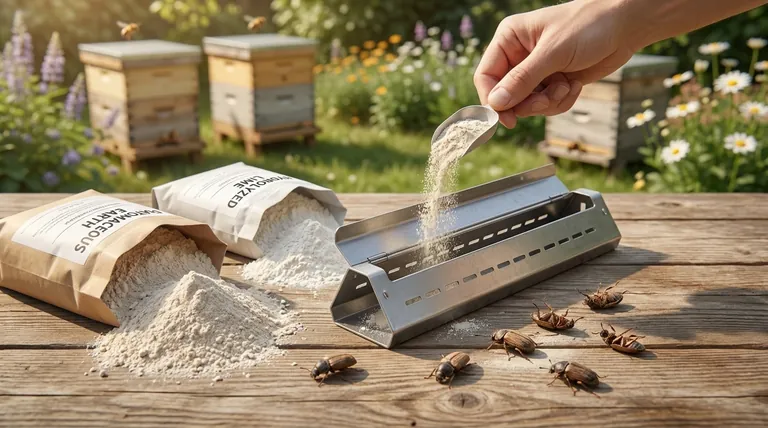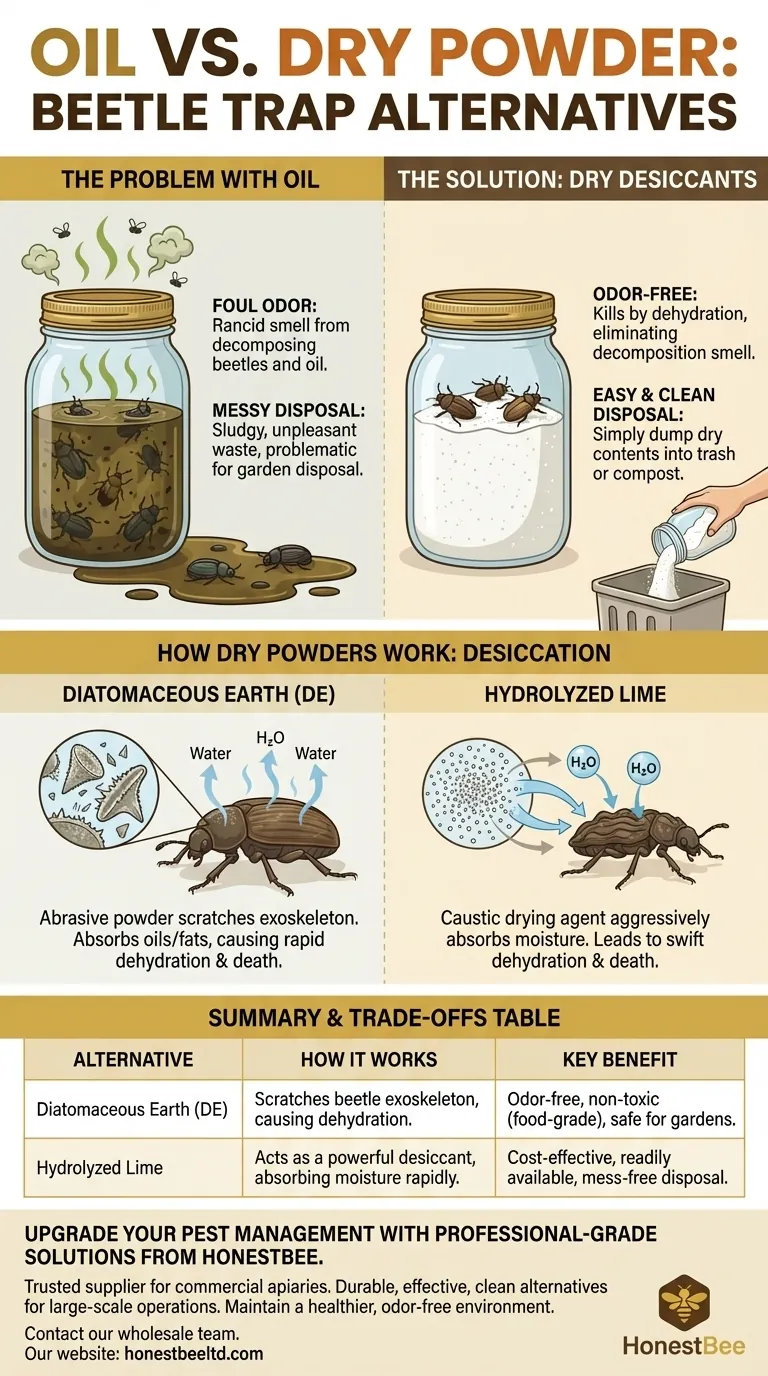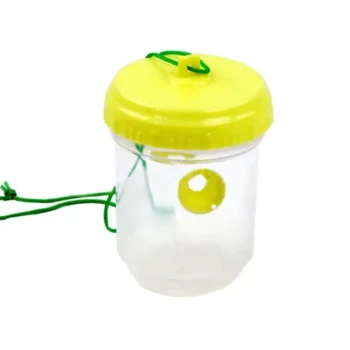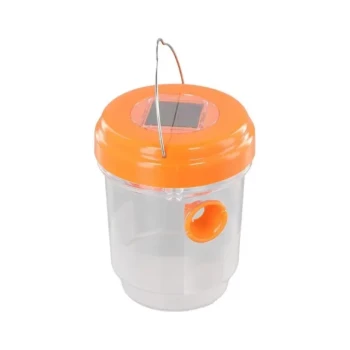For beetle traps, the recommended alternatives to oil are dry powders like diatomaceous earth or hydrolyzed lime. These substances effectively kill the trapped beetles through dehydration, which eliminates the significant odor and mess associated with using oil or water.
The core problem with using oil in beetle traps isn't the oil itself, but the rancid odor produced by decomposing beetles. Switching to a dry desiccant like diatomaceous earth or lime solves this by quickly drying the pests out, offering a cleaner, more effective, and odor-free method of disposal.

Why Move Away From Oil in Traps?
While oil effectively drowns beetles, it creates secondary problems that many gardeners and homeowners find intolerable. Understanding these issues clarifies why dry alternatives are a superior solution.
The Problem of Odor
When beetles are trapped in oil or water, they drown and begin to decompose. This mixture of decomposing insects and rancid oil produces an extremely foul odor that can permeate a large area of your yard.
The Mess and Disposal Challenge
Emptying a trap filled with an oily, sludgy mixture of dead beetles is an unpleasant task. It's messy, and disposing of the oily waste can be problematic, as it shouldn't be poured directly onto your lawn or garden.
Understanding the Dry Powder Alternatives
The most effective alternatives work on the principle of desiccation (dehydration) rather than drowning. This fundamental difference is what makes them so much cleaner and easier to use.
How Diatomaceous Earth (DE) Works
Diatomaceous earth is a fine powder made from the fossilized remains of tiny aquatic organisms called diatoms. On a microscopic level, DE particles are very sharp and abrasive.
When a beetle comes into contact with DE, the powder scratches and absorbs the oils and fats from the waxy outer layer of its exoskeleton. This breach allows moisture to escape, causing the beetle to rapidly dehydrate and die.
How Hydrolyzed Lime Works
Hydrolyzed lime (also known as hydrated lime or slaked lime) is a caustic powder that is a powerful drying agent. It functions purely as a desiccant.
When beetles fall into a trap containing lime, the powder aggressively absorbs moisture from their bodies. This leads to swift dehydration and death, effectively neutralizing them before decomposition can begin.
The Primary Benefit: Odor and Mess Elimination
Because both DE and lime kill by drying, the source of the foul smell is eliminated. You are left with a collection of dry, dead beetles. This makes trap maintenance incredibly simple—you can just dump the dry contents into the trash or a compost pile without any mess or odor.
Understanding the Trade-offs
While dry powders are a significant upgrade from oil, it's important to handle them correctly and understand their properties.
Effectiveness
Dry powders are highly effective at killing and containing beetles. Unlike a liquid surface that beetles might struggle on, there is no escape from a container filled with a fine, abrasive powder.
Safety and Handling
Both DE and hydrolyzed lime are fine powders that can cause irritation if inhaled. When filling or emptying your traps, it is wise to wear a simple dust mask and gloves, especially on a windy day.
For maximum safety, always choose food-grade diatomaceous earth. It is purified and considered non-toxic for use in gardens and around homes.
Environmental Considerations
Both diatomaceous earth and lime are natural mineral substances. They do not introduce harmful synthetic chemicals into the environment and are generally considered safe for garden disposal in the quantities used for traps.
Making the Right Choice for Your Goal
Selecting the best dry alternative depends on your priorities regarding safety, cost, and availability.
- If your primary focus is ease of use and cleanliness: Both diatomaceous earth and hydrolyzed lime are far superior to oil, offering a simple, mess-free, and odor-free disposal process.
- If your primary focus is absolute safety: Choose food-grade diatomaceous earth, as it is specifically processed to be non-toxic and is the safest option for use around pets, children, and vegetable gardens.
- If your primary focus is cost and availability: Hydrolyzed lime is often inexpensive and readily available at garden centers or hardware stores, making it a very practical choice.
By switching to a dry desiccant, you can manage your pest problem more effectively and without the unpleasant side effects of traditional methods.
Summary Table:
| Alternative | How It Works | Key Benefit |
|---|---|---|
| Diatomaceous Earth (DE) | Scratches beetle exoskeleton, causing dehydration. | Odor-free, non-toxic (food-grade), safe for gardens. |
| Hydrolyzed Lime | Acts as a powerful desiccant, absorbing moisture rapidly. | Cost-effective, readily available, mess-free disposal. |
Upgrade your pest management with professional-grade solutions from HONESTBEE. As a trusted supplier for commercial apiaries and beekeeping equipment distributors, we provide durable, effective alternatives to messy beetle traps. Our products are designed for large-scale operations that demand cleanliness and efficiency. Let us help you maintain a healthier, odor-free environment for your bees. Contact our wholesale team today to discuss bulk pricing and tailored solutions for your business.
Visual Guide

Related Products
- Reusable Aluminium Beetle Trap for Small Hive Beetles Silver Bullet
- Removable Washable Hive Beetle Trap Attractants for Small Hive Beetles
- Reusable Clear Small Hive Beetle Traps for Beehives Beetle Trapping Tools
- Black Plastic Beetle Barn Hive Beetle Trap for Beehives
- Plastic Beetle Blaster Trap Beekeeping Tools and Supplies
People Also Ask
- How do beetle blasters work to protect bee colonies? Effective IPM for Healthy Hives
- How do hive beetle traps work? A Beekeeper's Guide to Non-Chemical Control
- How should filled beetle traps be handled? Safely Remove and Dispose to Protect Your Hive
- What are the chemical-free options for trapping hive beetles? Control Pests Without Chemicals
- Where is the ideal placement for Beetle Blasters in a hive? Maximize Control with Strategic Positioning



















